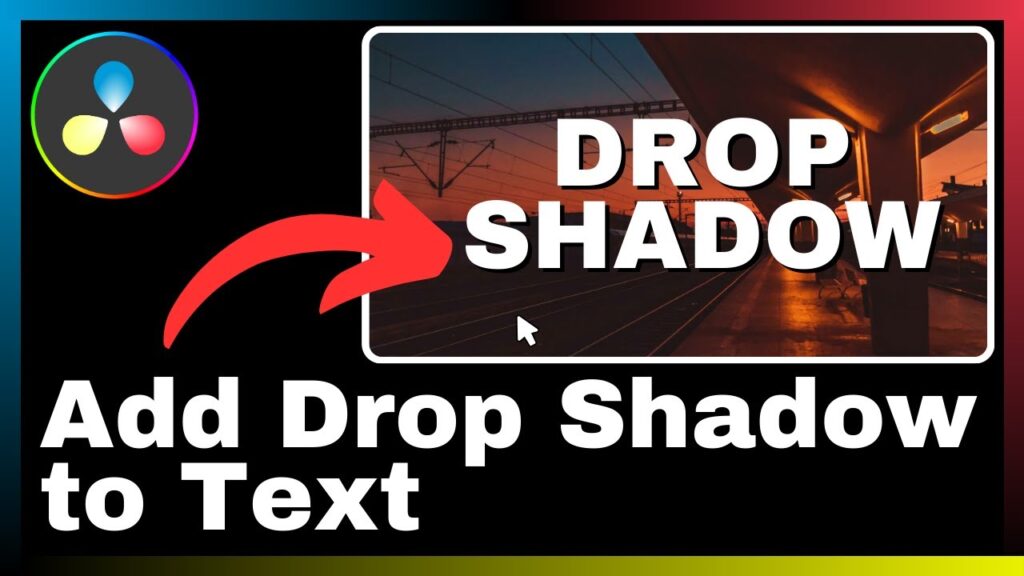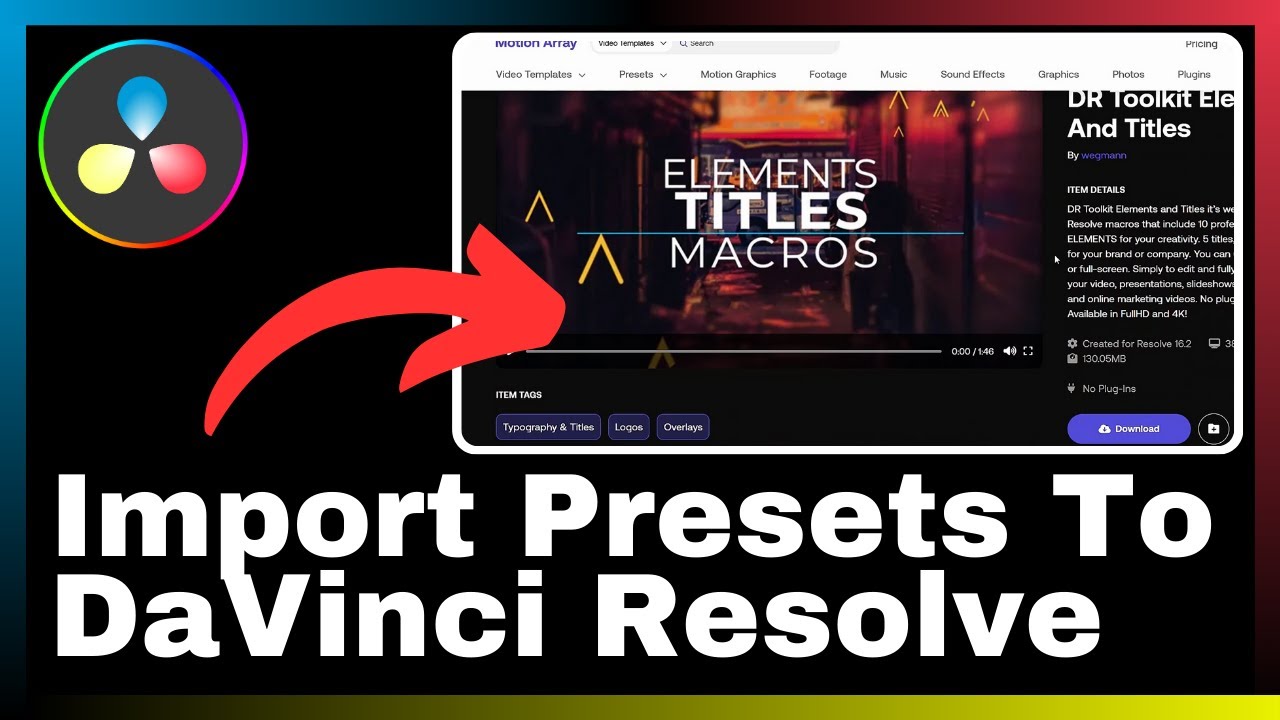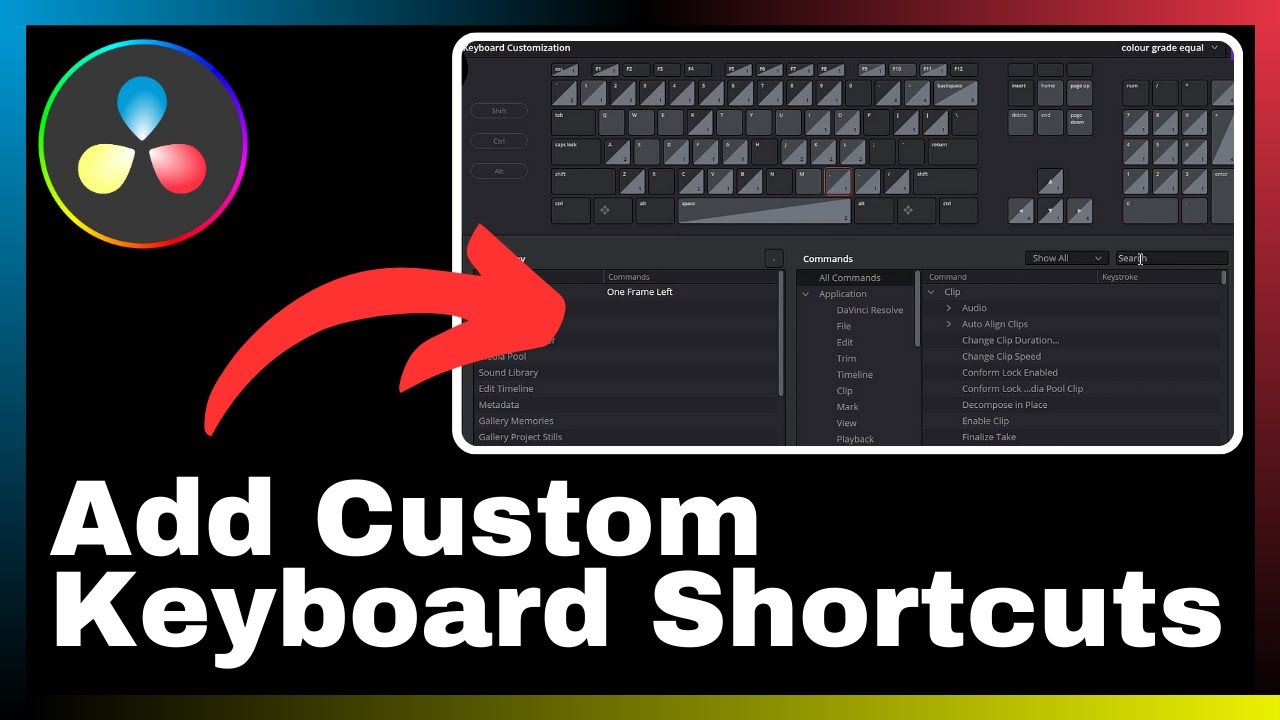In the digital age, video editing has become an essential skill for content creators, whether for personal or professional use. If you’re looking to enhance the visual appeal of your videos, adding a drop shadow effect to text elements can be a game-changer. In this tutorial by Media Magnet Guide, we will walk you through the process of applying a drop shadow to text in DaVinci Resolve, a powerful software that combines video editing, color correction, visual effects, and audio post-production tools all in one place. With step-by-step instructions and insightful tips, you’ll be able to elevate the visual quality of your videos and make them more engaging for your audience. So let’s dive right in and discover the magic of drop shadows in DaVinci Resolve!
DaVinci Resolve is renowned for its comprehensive set of tools that cater to both professionals and beginners, making it a sought-after choice for projects of all sizes and complexities. From basic editing to advanced visual effects, this software has it all. By incorporating a drop shadow effect to your text, you can add depth and dimension, making your titles and captions stand out. The Media Magnet Guide will guide you through the entire process, ensuring that you not only achieve the desired effect but also gain a deeper understanding of the capabilities of DaVinci Resolve. Get ready to transform your videos and captivate your audience with this invaluable tutorial.

Understanding DaVinci Resolve
DaVinci Resolve is a powerful software that combines video editing, color correction, visual effects, and audio post-production capabilities. It offers a comprehensive set of tools for professionals and beginners, making it a popular choice for projects of all sizes and complexities.
Benefits of using DaVinci Resolve
There are several benefits to using DaVinci Resolve for your video editing needs. First and foremost, it is a professional-grade software that is widely used in the industry. This means that you can trust the software to deliver high-quality results and meet the demands of your project.
Secondly, DaVinci Resolve offers a wide range of features and tools that allow you to have full control over your video editing process. Whether you’re looking to make simple cuts or complex edits, the software provides the necessary tools to achieve your desired outcome.
Additionally, DaVinci Resolve is known for its advanced color grading capabilities. The software provides a robust set of color correction tools that allow you to enhance the visual aesthetics of your videos. This is particularly important for projects that require precise color grading, such as commercials or films.
Finally, DaVinci Resolve offers seamless integration with other software and hardware tools. Whether you’re using a specific camera or working with a team of editors, DaVinci Resolve allows for easy collaboration and compatibility.
Most common features in DaVinci Resolve
While DaVinci Resolve offers a vast array of features, there are a few that are particularly popular and commonly used by editors. These include:
-
Color Grading: DaVinci Resolve is widely regarded as one of the best software applications for color grading. It provides a comprehensive set of color correction tools that allow you to achieve the desired aesthetic for your videos.
-
Audio Post-Production: In addition to video editing, DaVinci Resolve also offers robust audio editing capabilities. This includes features such as audio mixing, noise reduction, and audio effects.
-
Motion Graphics: DaVinci Resolve enables users to create stunning motion graphics and visual effects. With its powerful tools and intuitive interface, you can easily add animated titles, transitions, and graphics to enhance your videos.
-
Collaboration: DaVinci Resolve allows for seamless collaboration between team members. This includes features like sharing projects, managing multiple users, and version control.
-
Exporting: Once you’ve completed your editing and post-production process, DaVinci Resolve offers various options for exporting your final video. Whether you’re looking to publish online or create a high-resolution master file, the software provides the necessary export settings.
Creating Text Elements in DaVinci Resolve
Text elements are commonly used in videos to convey important information, such as titles, subtitles, or captions. DaVinci Resolve offers a user-friendly interface for creating and customizing text elements.
To create text in DaVinci Resolve, you can follow these basic steps:
- Open your project in DaVinci Resolve and navigate to the timeline.
- Select the video clip or frame where you want to add the text element.
- Go to the toolbar and click on the “Text” tool.
- A textbox will appear on the screen, allowing you to enter your desired text.
- Use the text properties panel to adjust the font, size, color, and other formatting options.
In addition to choosing and modifying fonts, you can also position the text on the video frame. DaVinci Resolve provides tools for adjusting the alignment, position, and scale of the text element. This allows you to perfectly position the text wherever you want it to appear in the video.
Understanding these basics of creating text elements in DaVinci Resolve will help you add professional-looking titles and captions to your videos.
Understanding the Concept of Drop Shadow
The drop shadow effect is a widely used technique in video editing, as it adds depth and dimension to text elements. By adding a shadow behind the text, the drop shadow effect makes the text stand out and appear more visually appealing.
The drop shadow effect refers to the shadow that is cast by an object onto a surface behind it. In the context of video editing, this effect is applied to text elements to create the illusion of depth and make them visually pop.
There are several benefits of using the drop shadow effect in video editing. First, it enhances the readability of the text by making it more distinct from the background. This is particularly useful when working with complex or busy backgrounds where the text might get lost.
Secondly, the drop shadow effect can be used to add a sense of realism and depth to your videos. By creating a shadow that mimics real-world lighting conditions, you can make your text elements appear more three-dimensional and integrated into the scene.
The drop shadow effect can be used in a variety of situations in video editing. It is commonly employed in title sequences, lower thirds, and captions. Additionally, it can be used to highlight specific information or draw attention to important elements in a video.
Understanding the concept and benefits of the drop shadow effect will allow you to effectively use this technique to enhance the visual appeal and readability of your text elements in DaVinci Resolve.
Setting Up the Workspace
Before diving into the specifics of adding drop shadow effects to text in DaVinci Resolve, it’s important to familiarize yourself with the software’s workspace and layout. By understanding the different tools and panels available, you can navigate through the workspace more efficiently and make the most of your editing process.
DaVinci Resolve offers different workspace layouts, each tailored to specific editing tasks. When starting a new project, it’s essential to choose the right workspace layout that suits your needs. The main workspace layouts in DaVinci Resolve include:
-
Edit: This layout is designed for video editing and provides a timeline for arranging and trimming clips, as well as tools for adding transitions, effects, and titles.
-
Color: The color workspace is dedicated to color grading and offers a range of tools for adjusting the color, contrast, and overall look of your footage.
-
Fairlight: The Fairlight workspace focuses on audio editing and provides tools for mixing, editing, and enhancing the audio in your videos.
-
Fusion: The Fusion workspace is where you can create advanced visual effects and motion graphics using the node-based compositing system.
Once you’ve selected the appropriate workspace layout, it’s essential to understand the different tools and panels available within that workspace. DaVinci Resolve provides various tools for editing, color grading, audio post-production, and visual effects. Familiarize yourself with these tools and their functions to effectively navigate through the workspace.
Navigating through the workspace can be done using keyboard shortcuts or by using the mouse to click and drag on various elements. Take the time to explore the different panels and features of the workspace to become comfortable with the interface and streamline your editing process.
How to Select Text
Selecting text in DaVinci Resolve is a crucial step in making modifications or applying effects to specific text elements. It allows you to isolate the text you want to work with from the rest of the video footage or other elements in the scene.
The process of selecting text in DaVinci Resolve is straightforward. Here are the steps to follow:
- Open your project in DaVinci Resolve and navigate to the timeline.
- Locate the text element you want to select and click on it with the mouse.
- The text element will be highlighted or bounded by a selection box, indicating that it is now selected.
Text selection is essential because it allows you to make modifications or apply effects to the selected text without affecting other text elements or video footage in the scene. It gives you precise control over the text you want to work with and ensures that your edits are focused and targeted.
In addition to the basic process of selecting text, DaVinci Resolve offers different techniques to select text more efficiently. These techniques include using keyboard shortcuts to select all text elements, selecting multiple text elements at once, or using selection tools to choose specific text regions.
Understanding the importance of text selection and mastering the different techniques available in DaVinci Resolve will significantly enhance your editing workflow and efficiency.
Accessing the Effects Library
The effects library in DaVinci Resolve is a repository of various visual effects, transitions, and enhancements that you can apply to your video footage and text elements. It provides a wide range of creative options to enhance and customize your videos.
To open the effects library in DaVinci Resolve, you can follow these steps:
- Open your project in DaVinci Resolve and navigate to the edit page.
- Locate the effects library panel on the right side of the screen.
- Click on the effects library tab to expand it and access the available effects.
Once you have opened the effects library, it’s essential to understand the layout and navigation options available. DaVinci Resolve categorizes effects into different sections, making it easier to search and browse for specific effects. These sections may include transitions, generators, titles, and more.
Within each section, you can further refine your search by using keywords or filters. This allows you to find the specific effect you’re looking for quickly. You can also preview the effects by hovering over them, which provides a real-time preview of how the effect would look on your video.
Finding the drop shadow effect in the effects library is a crucial step in adding the effect to your text elements. By understanding the layout and navigation options in the effects library, you can efficiently locate and apply the desired drop shadow effect to your text elements.
Adding Drop Shadow to Text
To add a drop shadow effect to text elements in DaVinci Resolve, you can follow these detailed steps:
- Select the text element you want to add a drop shadow to by clicking on it in the timeline or using the text selection techniques mentioned earlier.
- Go to the effects library panel and navigate to the section where drop shadow effects are listed.
- Locate the drop shadow effect you want to apply and click on it to select it.
- Drag and drop the drop shadow effect onto the selected text element in the timeline.
- The drop shadow effect will be applied to the text, and you can adjust its settings and parameters in the effects controls panel.
Once you have added the drop shadow effect to your text element, you can preview and adjust the effect to achieve the desired look. DaVinci Resolve provides a real-time preview of the effect, allowing you to see how it affects the text in the context of the video.
To adjust the drop shadow effect, you can modify parameters such as the opacity, distance, angle, and color of the shadow. Experiment with these settings to achieve the desired result.
When working with drop shadow effects, it’s important to keep in mind some tips for creating effective drop shadow effects. These include:
-
Subtlety: Avoid using excessive or overbearing drop shadows. The effect should enhance the text element without overshadowing it.
-
Consistency: Keep the drop shadow consistent throughout the video to maintain a cohesive visual style.
-
Compatibility: Ensure that the drop shadow is compatible with the color and overall aesthetic of the video. Experiment with different colors and settings to find the best match.
By following these steps and tips, you can effectively add drop shadow effects to your text elements in DaVinci Resolve and enhance their visual impact.
Advanced Drop Shadow Techniques
While the basic steps covered earlier allow you to add a drop shadow effect to your text elements, DaVinci Resolve offers several advanced techniques to further customize and refine the drop shadow effect. These techniques give you more control over the appearance and behavior of the drop shadow.
One advanced technique is adjusting the opacity and distance of the drop shadow. By modifying the opacity, you can control the intensity of the shadow and achieve different levels of transparency. Changing the distance of the shadow allows you to control how far the shadow is cast from the text element.
Another advanced technique is changing the color of the drop shadow. DaVinci Resolve provides a wide range of options for customizing the color of the shadow. You can choose a color that complements the text or matches the overall theme of the video.
Furthermore, you can apply multiple drop shadows to a single text element. This technique can create complex and layered visual effects, adding depth and sophistication to your text elements. You can experiment with different settings for each drop shadow layer to achieve the desired result.
By mastering these advanced drop shadow techniques, you can take your text elements to the next level and create visually stunning effects in DaVinci Resolve.
Saving and Exporting Your Project
Once you have finished editing and applying drop shadow effects to your text elements, it’s essential to save your project in DaVinci Resolve. Saving your project ensures that you don’t lose any progress and allows you to return to it later for further modifications or exporting.
To save your project in DaVinci Resolve, you can follow these steps:
- Go to the file menu at the top of the screen.
- Click on “Save” or “Save As” to open the save dialog box.
- Choose a location on your computer to save the project file.
- Enter a name for the project file and click “Save” to save your project.
While saving your project in DaVinci Resolve is crucial for workflow management, you may also need to export it for final delivery or distribution. DaVinci Resolve offers various options for exporting your project, depending on your specific requirements.
To export your project in DaVinci Resolve, you can follow these steps:
- Go to the deliver page in DaVinci Resolve.
- Set the export settings, such as the format, resolution, and codec.
- Specify the output destination for the exported video file.
- Click on the “Start Render” button to initiate the export process.
DaVinci Resolve provides a range of export options, allowing you to choose the format and settings that best suit your needs. Whether you’re looking to publish online, create a high-resolution master file, or export for specific devices or platforms, DaVinci Resolve has you covered.
When exporting your project, it’s important to ensure the quality of the exported video. DaVinci Resolve provides options to control the bitrate, compression, and other settings to optimize the quality of the exported video. Take the time to review and adjust these settings to achieve the desired output quality.
By saving and exporting your project in DaVinci Resolve, you can preserve your work and deliver the final video in the appropriate format and quality.
Conclusion
In conclusion, adding a drop shadow effect to text elements in DaVinci Resolve can greatly enhance the visual appeal and readability of your videos. By understanding the fundamentals of creating text elements, selecting text, and navigating through the workspace, you can effectively add drop shadow effects to your text elements.
DaVinci Resolve offers a comprehensive set of tools and features for video editing, color grading, audio post-production, and visual effects. By utilizing these tools and techniques, you can unleash your creativity and create professional-quality videos.
While the drop shadow effect is just one example of the creative possibilities in DaVinci Resolve, the software offers many other effects and enhancements that you can explore. Continued learning and practice with DaVinci Resolve will allow you to further refine your skills and unlock even more potential in your video editing projects.
As DaVinci Resolve continues to evolve and improve, we can expect further enhancements and features in future versions. By staying updated with the latest developments and advancements in the software, you can stay at the forefront of video editing technology and deliver exceptional results.
Remember, practice makes perfect, and the more you explore and experiment with DaVinci Resolve, the better equipped you’ll be to handle a wide range of video editing projects. So, embrace the power of DaVinci Resolve and let your creativity shine.


























